What is cork wallpaper?
Cork wallpaper is a completely natural, harmless material made from oak bark. Cork covering is produced in three variations: wallpaper, panels and rolls. The first type has a paper or non-woven base under the cork surface. The covering has a limited color palette in warm tones, differing only in shades.
Production technology
Cork wallpaper is made from oak bark, which is removed from the trunk every decade, after which the tree continues to live and begins to grow again. The bark is crushed and pressed at high temperature, which produces a sticky substance, thanks to which the resulting material is applied to a base of non-woven fabric or paper.
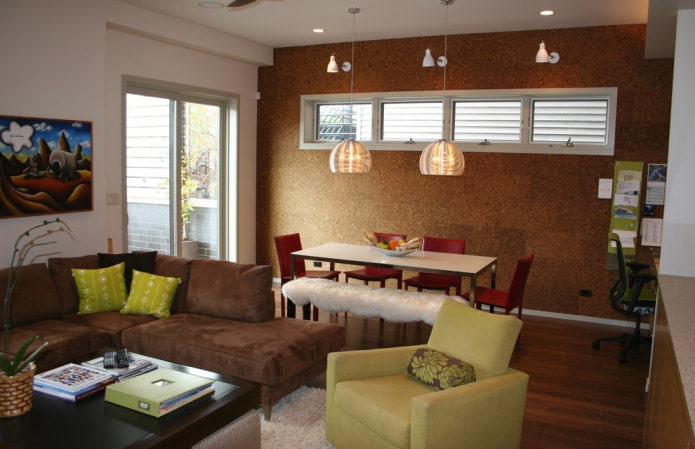
Characteristics
Cork sheets have quite convenient parameters, which are somewhat different from conventional wallpaper coverings.
Features
Cork coverings are an absolutely natural surface, which gives them the right to be considered harmless, and therefore suitable for finishing children’s rooms and are not scary for allergy sufferers.
- Unlike many other materials, cork wallpaper boasts high soundproofing indicators.
- An important feature is the ability to retain heat in cold weather and, conversely, coolness when it’s hot outside.
Cork wallpaper can be divided into two types: those coated with wax and those not. Such materials differ in price and characteristics. The surface protected with wax does not absorb odors, but is more expensive. Canvases without a protective coating are called porous; they are not recommended for use in finishing kitchens and rooms where there may be unpleasant odors.
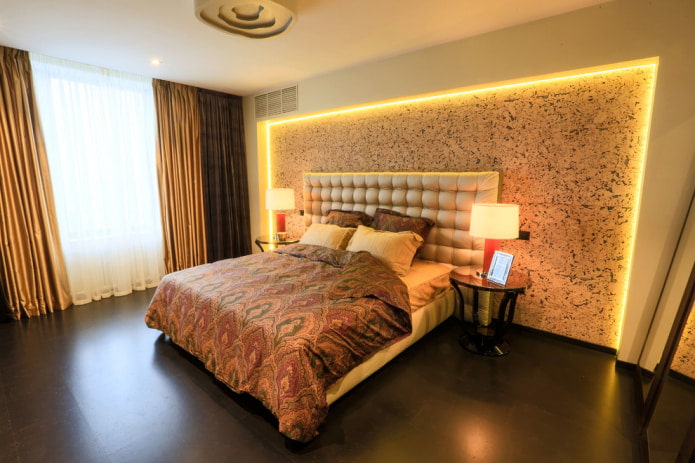
What types are there?
On a paper or non-woven base
The most common type of cork wallpaper. The material is easy to repair and has a relatively low cost compared to slabs and rolls. As with other types of wallpaper, in this case there is a base on which oak veneer is applied after the preparation procedure.
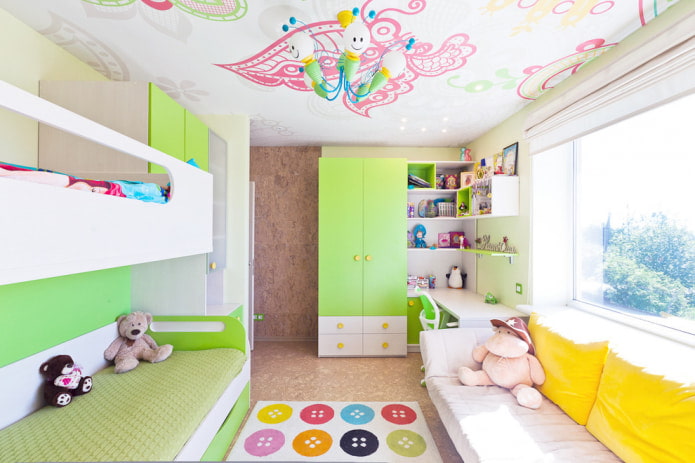
Self-adhesive
The coating has a base of adhesive paper and protective film. The cork is applied directly over the paper. This type of coating greatly simplifies the work. When finishing, it is especially important to carefully apply the canvas to the wall surface and measure the joints precisely, since there will be no opportunity to make adjustments.

In addition to walls, self-adhesive wallpaper can be used to decorate door and window openings or update furniture.
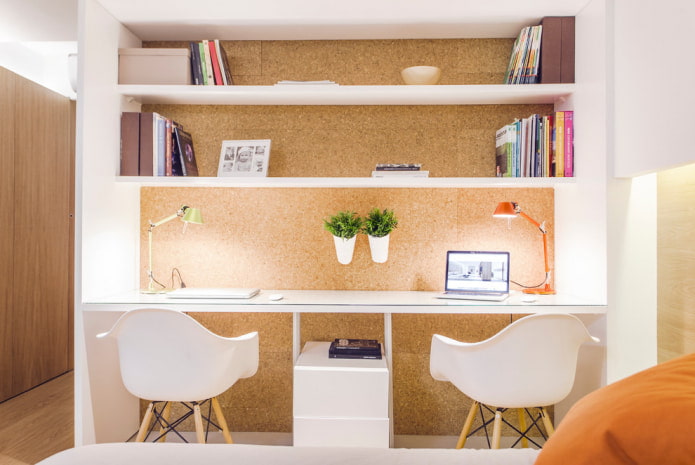
Without base
The most environmentally friendly, but at the same time very fragile material. The base performs a binding and strengthening function, this type of canvas does not provide it. The coating is made of pressed pieces of tree bark, which are glued together with a substance released when heated.
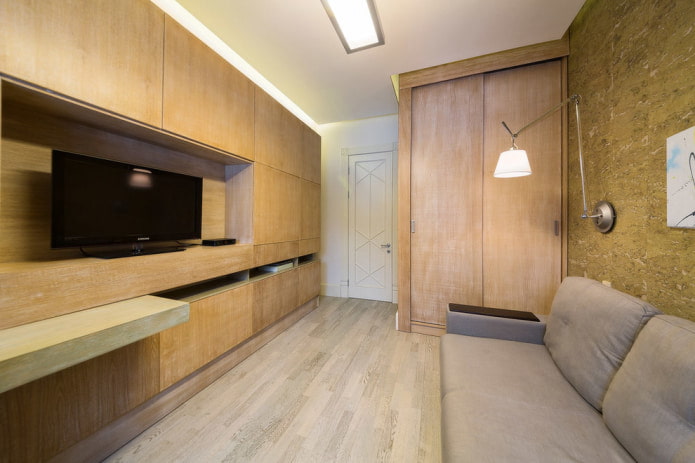
Liquid
Liquid cork wallpaper is packaged and sold as a mixture consisting of oak bark chips and an acrylic-based substance. This type of finishing can decorate the interior and exterior of the building.
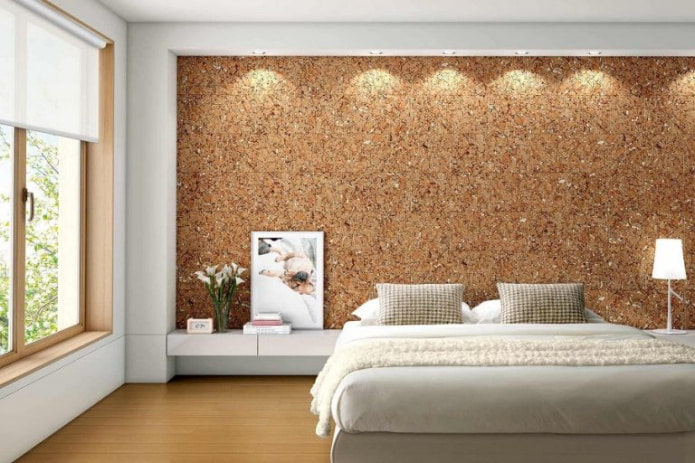
The composition is applied to the wall with a spatula or sprayer, the tool is determined by the desired final effect.
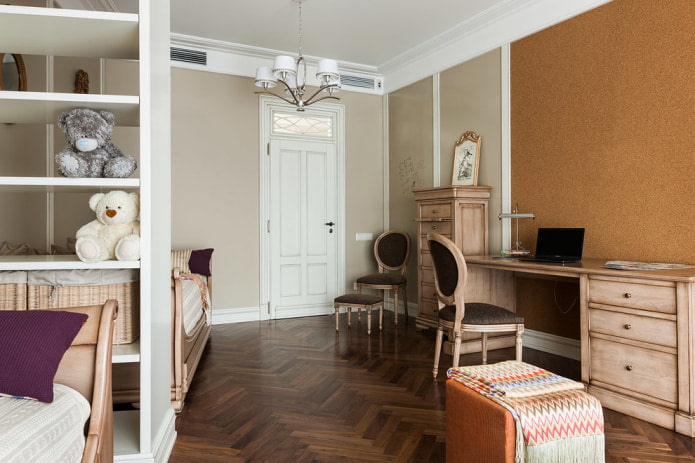
The photo shows a children’s room with a classic design. The room’s decoration and filling are done in warm colors from light beige to brown.
Pros and cons
Cork coverings have many advantages. However, the disadvantages should also be taken into account when choosing a material.
Photos in the interior of rooms
In the hallway
Considering the ease of care, cork wallpaper will be one of the best ways to decorate a hallway. The material can be combined with other types of wallpaper. Self-adhesive wallpaper can be used to decorate the most stain-sensitive areas.
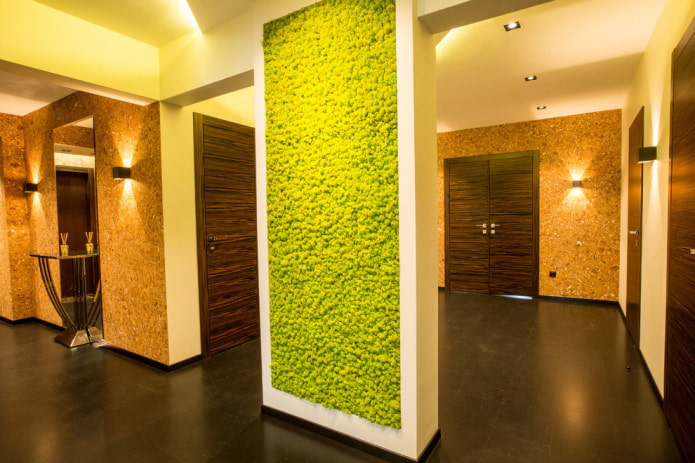
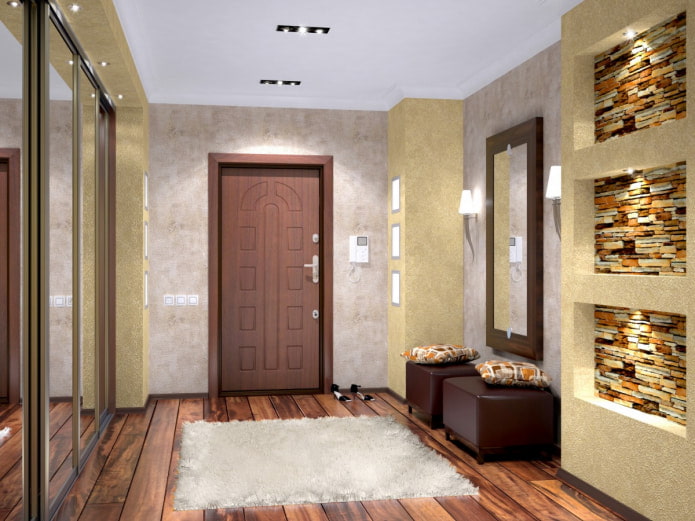
For the kitchen
For finishing the kitchen, it is worth using cork wallpaper with a wax coating, otherwise they will quickly absorb odors. Since the material is not afraid of moisture, the wallpaper can be used to finish the work area, namely the apron. The dining area will also look great, the natural material will make the interior more comfortable.
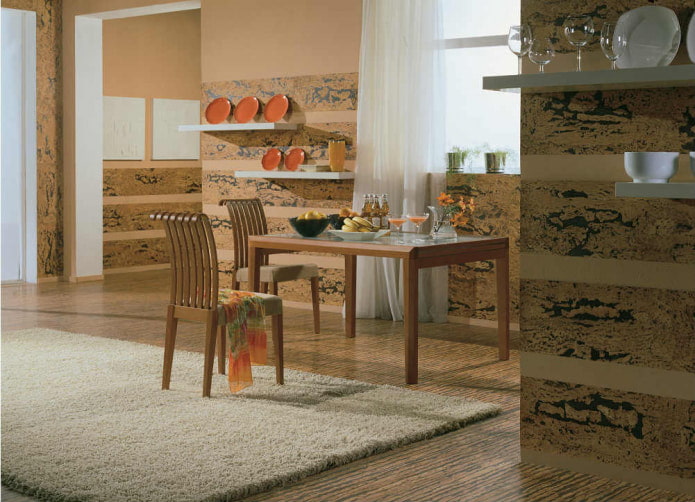
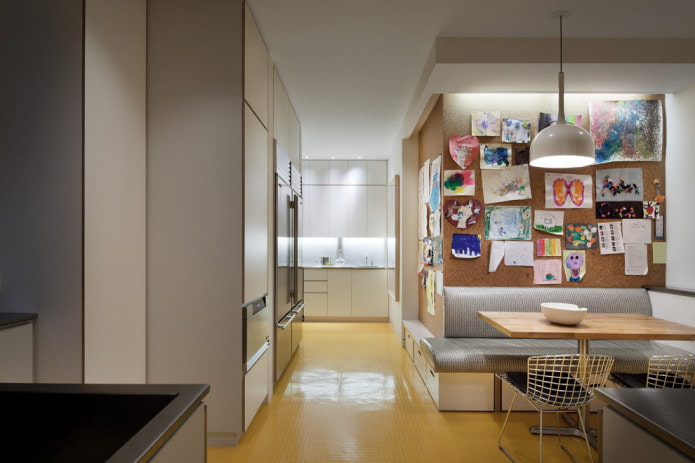
The photo shows a minimalist kitchen in light colors. The corner wall finished with cork wallpaper is convenient for placing children’s drawings and souvenirs.
In the bedroom
An interesting way to decorate a bedroom. Cork wallpaper has a soft warm surface and is perfect for decorating a bedside area, for example, at the head of the bed. Cork flooring will look harmonious in the interior of a modern, country and eco style.
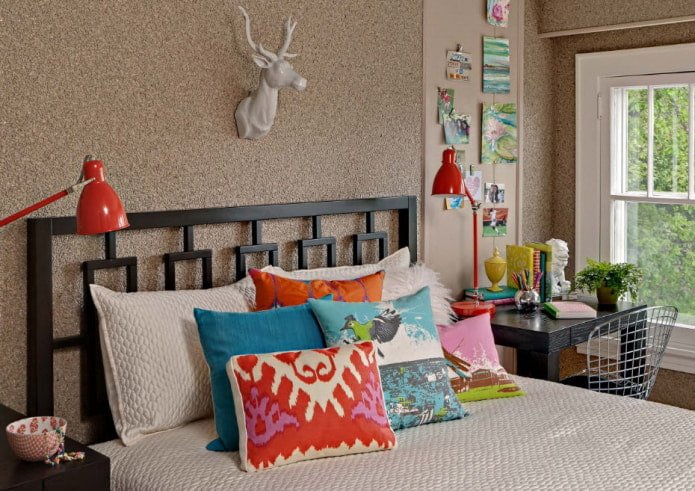
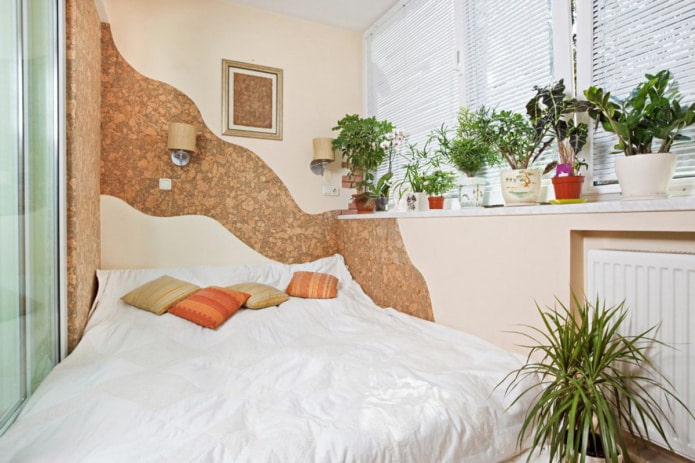
On the balcony
A good choice of material for a balcony and loggia. Cork wallpaper is not afraid of bright light and high humidity, in addition, it will save you from street noise. The color scheme allows you to decorate the interior in a light or dark palette. The finish can be combined with other materials, such as liquid wallpaper or wood panels.
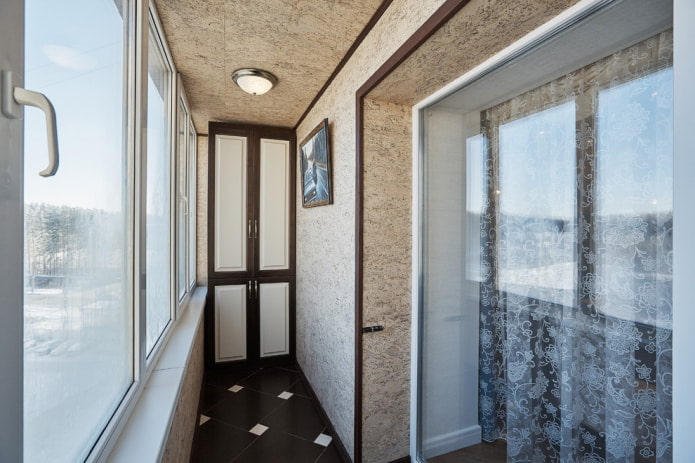
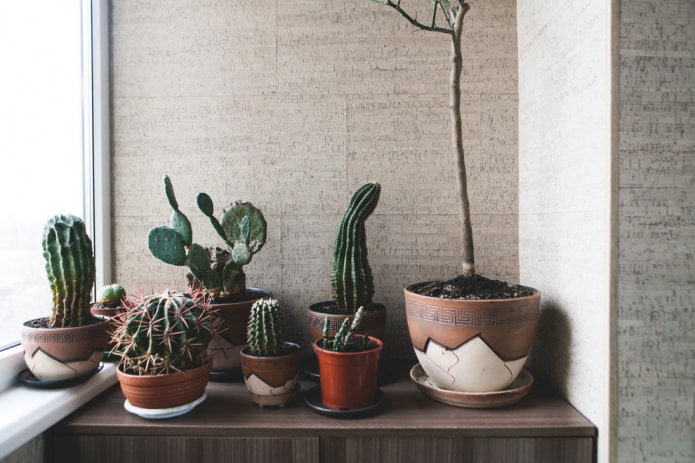
In the living room
Cork wallpaper will support the natural theme in the interior of the living room or hall. The decoration can be done along the entire perimeter of the room or highlight only certain areas, for example, behind the TV or sofa.
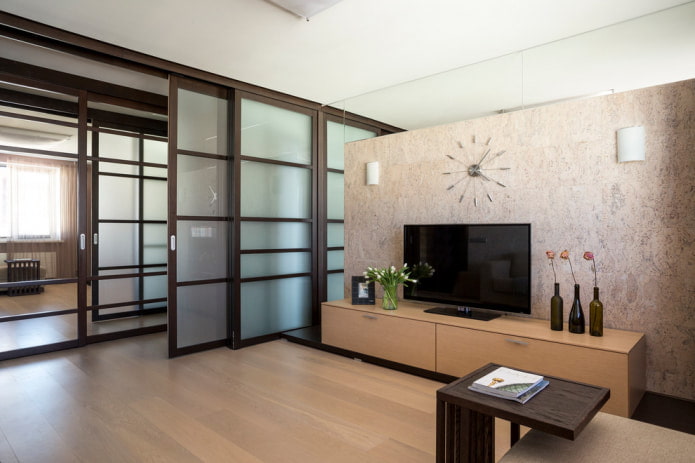
With the help of self-adhesive wallpaper, you can decorate certain elements or cut out some figure that will decorate the wall, for example, a tree.
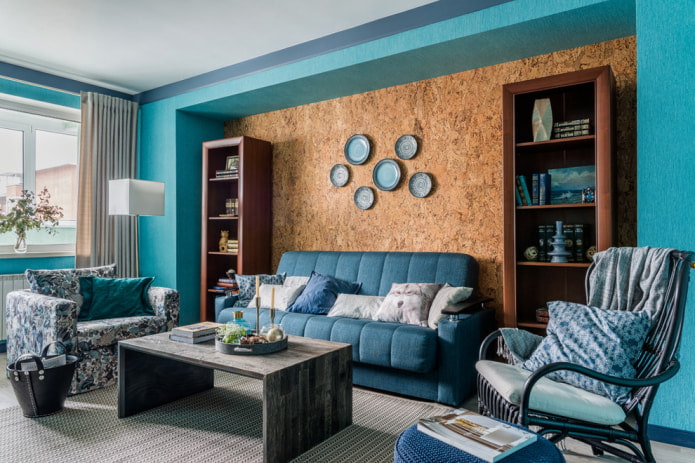
In the nursery
Cork wallpaper is good for a nursery in many ways. Firstly, it is an environmentally friendly material, you can not be afraid of allergic reactions or harmful substances.

The photo shows a children’s room. The wall is decorated with houses cut out of self-adhesive wallpaper.
The material will maintain a comfortable environment, keeping warm or cool, and the surface of the walls will always be warm and soft. The appearance of the wallpaper allows you to decorate the interior of the nursery in different styles.
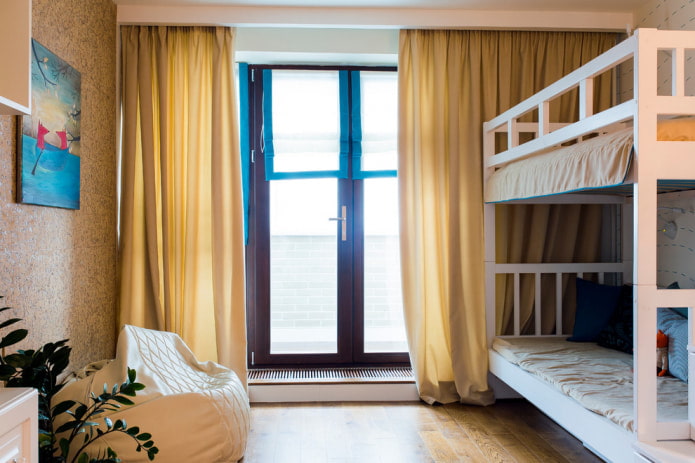
What can you combine it with?
Bamboo covering harmoniously coexists with other finishing materials, especially successful combinations are obtained with natural materials. Given the texture of the material, the design will not be pretentious and overloaded.
- With bamboo wallpaper. Similar materials look like a single whole. The decoration will look good in the hallway, living room and on the balcony.
- With other types of wallpaper. Cork covering can be combined with other types of wallpaper, such as paper, non-woven or vinyl. Considering the durability of cork and the short lifespan of paper wallpaper, this is not the most practical combination. Non-woven or vinyl will be a more suitable choice, and the variety of colors and textures will make the interior more interesting.
- With wooden panels. Materials close in nature are successfully combined in the interior of a balcony, hallway, living room or dining room. Both materials are practical and durable.
- With plaster. A smooth plastered wall will look good with a textured cork covering. Such a combination can decorate a living room, bedroom or hallway. The combination is neutral, calm.
- With stone or brick. The stone will stand out against the background of cork wallpaper. The combination is suitable for hallways, balconies or living rooms.
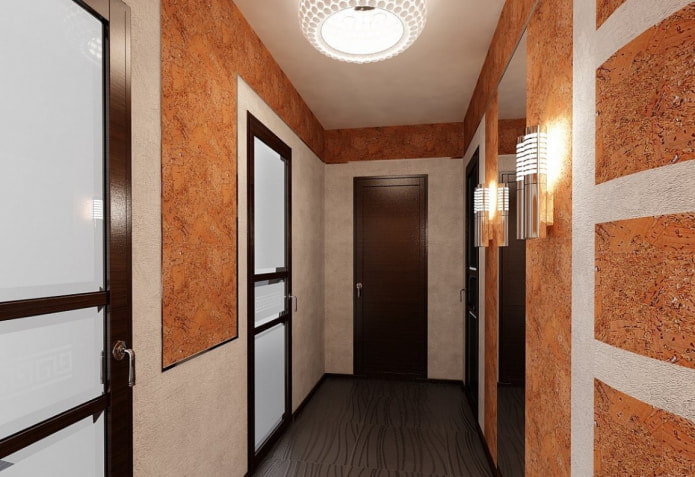
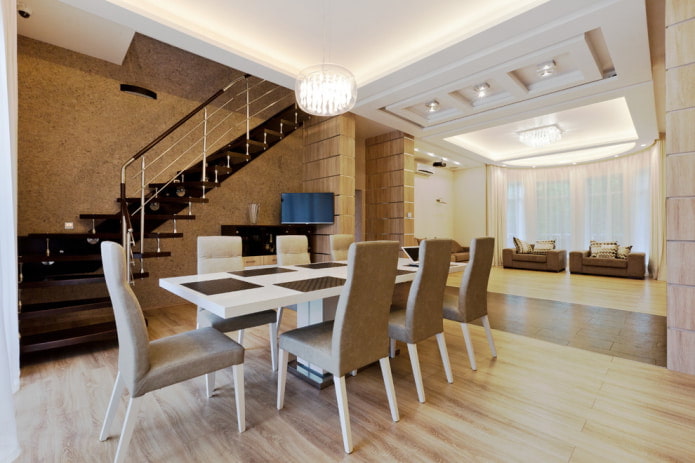
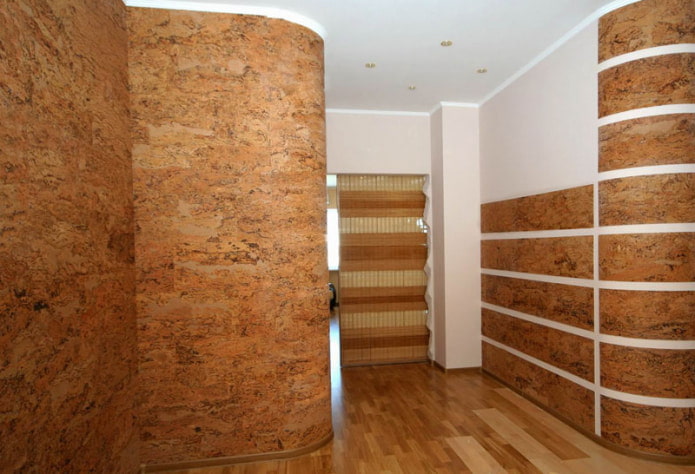
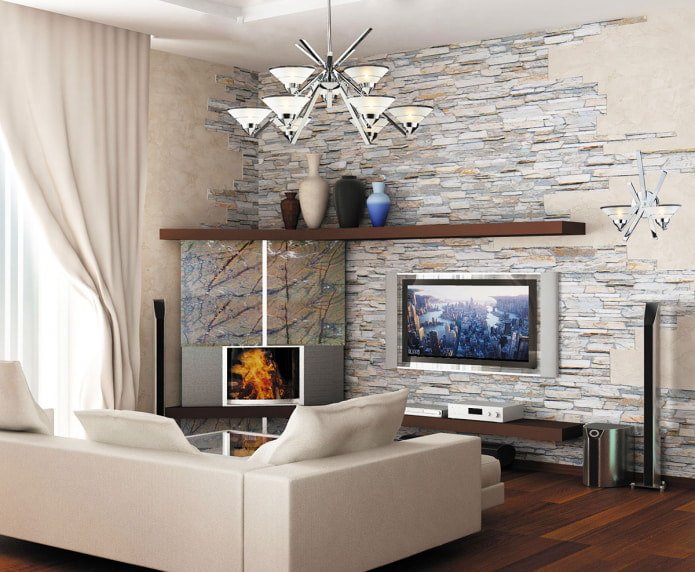
Presentation in various styles
Country
Considering the features of the stylistic direction, cork flooring will fit well into a cozy rustic style. The interior uses natural materials both for finishing and for filling the room. The walls can be decorated with a combination of cork and wooden boards, plaster or other types of wallpaper.
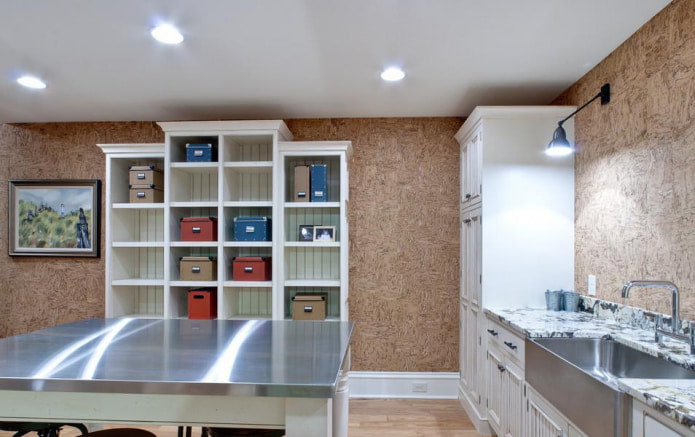
The photo shows a country style kitchen interior.
Eco-style
When creating an eco-style design, natural materials are used. The combinations can be varied, for example, with untreated wood. You can fully implement the eco-style in spacious rooms.
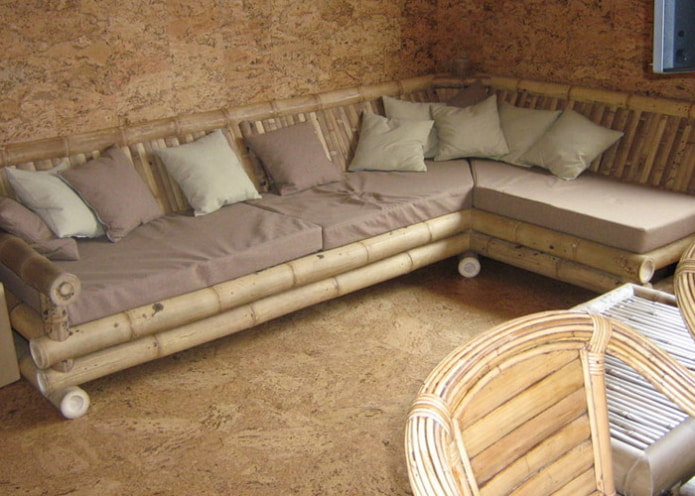
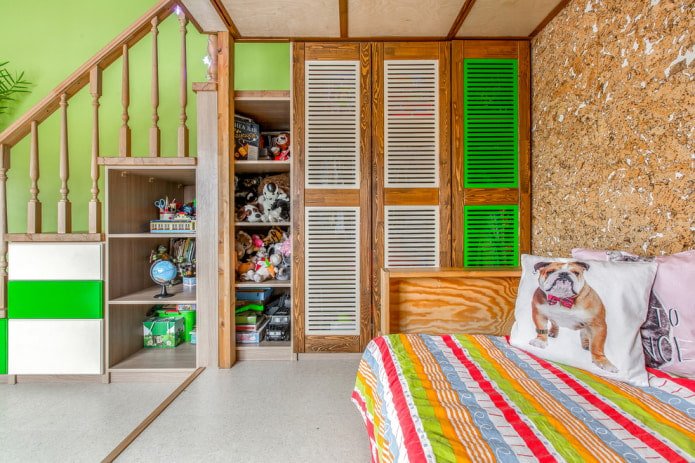
Ethnic style
Ethnic style is filled with mystery and unusual details. Subdued lighting and themed decorative elements will complete the interior picture.
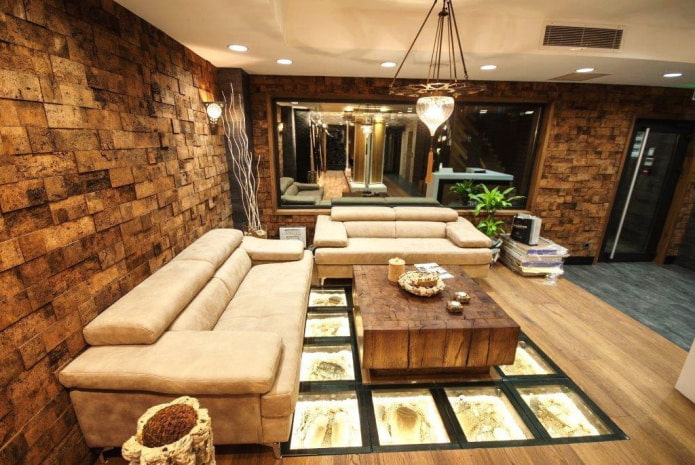
The interior can combine cork covering and vinyl wallpaper with a beautiful pattern or imitation of Venetian plaster.
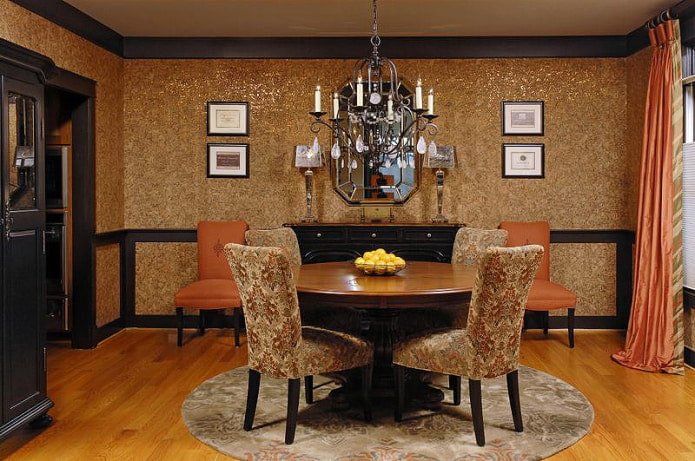
Loft
Walls in an urban style will look equally harmonious with and without finishing. Cork will make the loft interior softer and cozier, while maintaining the “zest” of the stylistic direction.

Pattern and colors
The color palette of cork flooring is not very diverse, however, it allows you to finish in light or dark colors. The range starts from light gray and sand and ends with dark brown and ocher.
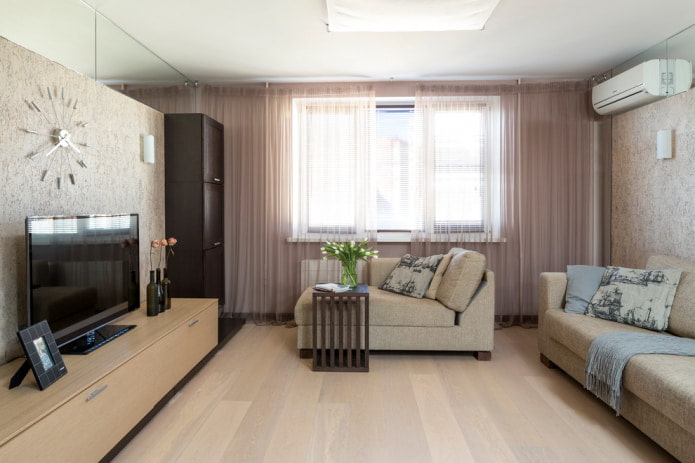
The pattern may vary, the surface can be uniform, with inclusions and of different density. To add color, the surface can be painted or varnished.
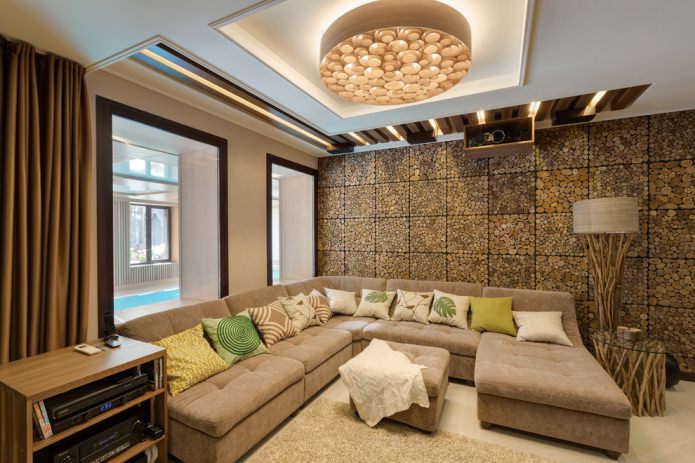
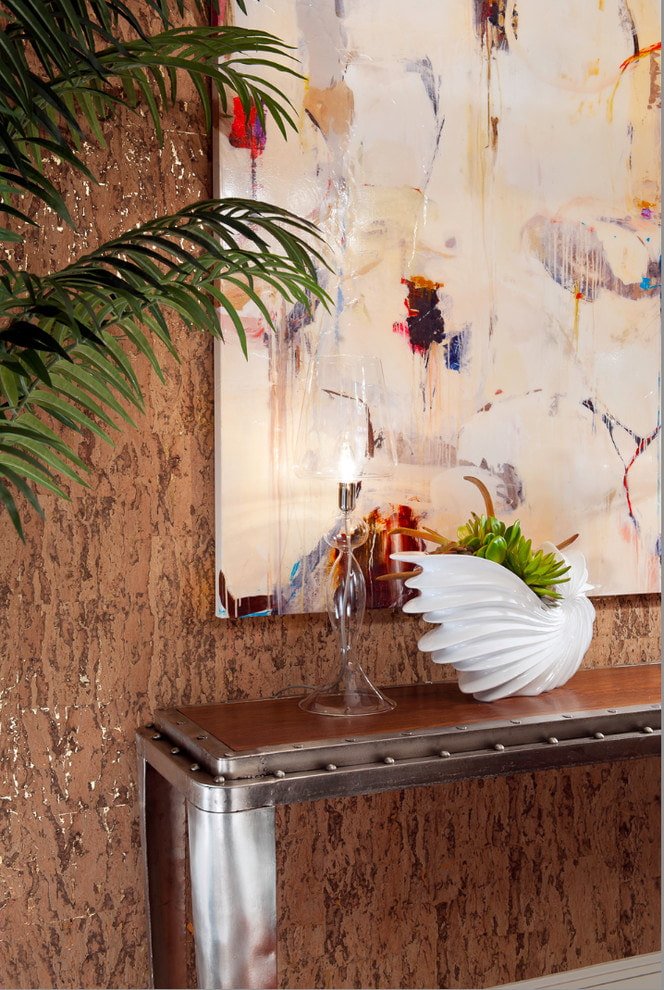
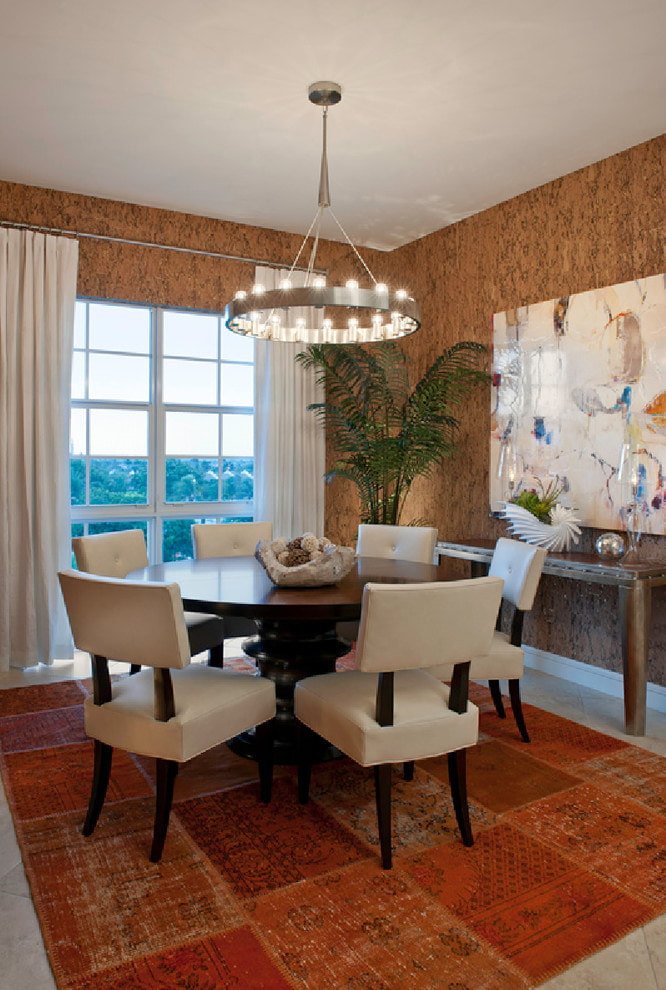
Finishing non-standard surfaces
In addition to walls, cork covering can decorate other surfaces and decorative elements. You can also use self-adhesive sheets to update some pieces of furniture, thereby making them unique.
Ceiling
An unusual finishing method will make the room design more interesting. For standard low-rise rooms, it is better to use a light-colored covering. In this case, the finishing will not make the ceilings visually lower, but will only stand out with an unusual texture.
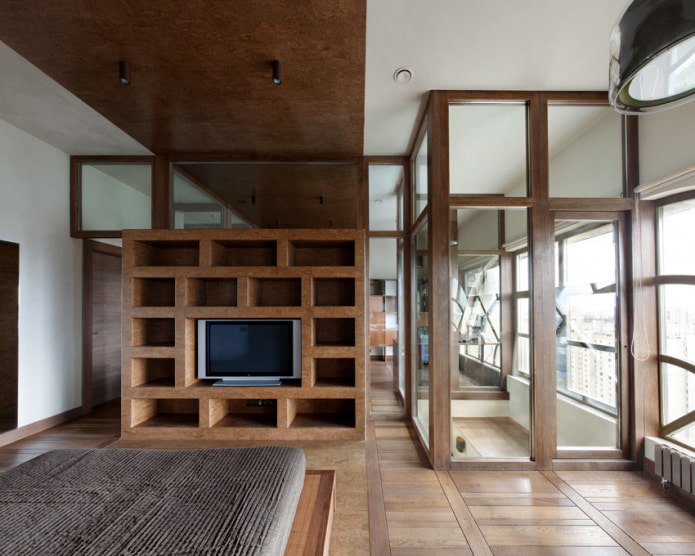
The photo shows an interior in a modern style. A strip of cork wallpaper on the ceiling visually stretches the space, without making it dark.
The wall decoration with cork covering, flowing onto the ceiling, looks interesting. This technique makes the room appear higher and unites the planes.
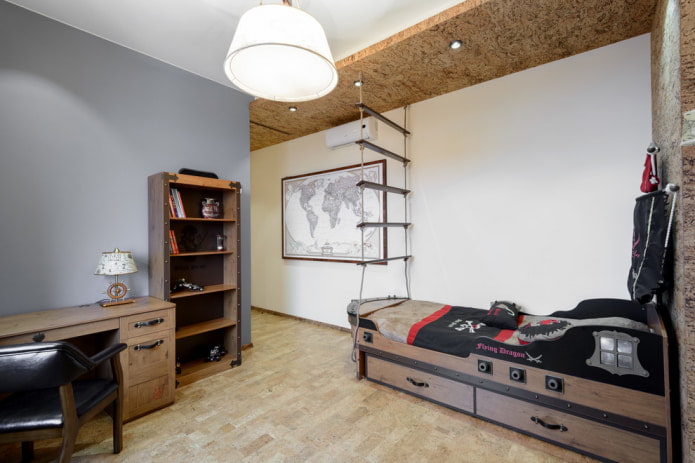
Interior doors
You can update an interior door and make it more interesting by finishing it with self-adhesive wallpaper. In addition to the aesthetic side, the coating will improve the soundproofing properties of the door. The decoration can be done by finishing the door completely or by decorating it partially with cut-out figures.
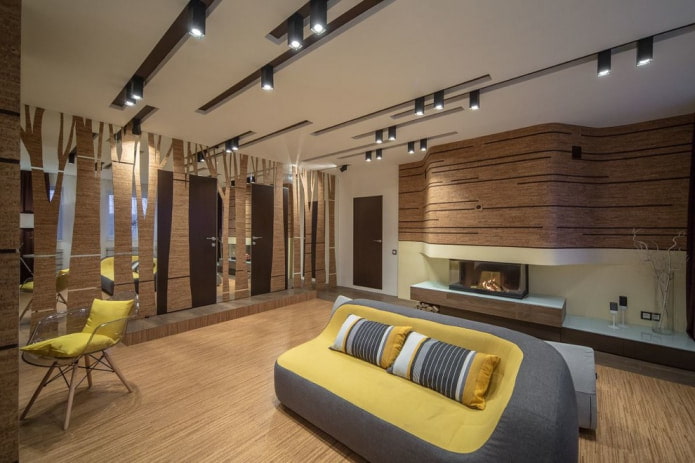
The photo shows a living room with complex wall decoration made of cork, liquid wallpaper and mirrors. The combination of materials makes the space larger and more interesting.
How to glue?
What kind of glue?
Cork is a fairly heavy material; in order for it to adhere securely to the wall, it is necessary to use a special adhesive composition. There is glue specifically for cork, it takes into account all the nuances of the material. If it is not possible to purchase such glue, you can choose another composition intended for heavy types of coatings. You can also use acrylic-based glue.
Painting technology
The technique for working with cork wallpaper is somewhat different from other types and has its own nuances.
- Before pasting, it is necessary to prepare the surface. To do this, the wall is cleaned of old finish, leveled and primed.
- Using a level or plumb line, a vertical line is marked, which will serve as a ruler for even pasting of the canvases. The line is marked from the middle of the wall and is equal to the width of the canvas.
- It is necessary to prepare the material. The wallpaper is cut into strips of the required length, after which it should be left to lie on the floor for a while.
- The glue is applied to the wall, on a part equal to the width of the strip, after which the strip of wallpaper is pressed to the surface.
- The strips are glued end to end, starting from the horizontal line in both directions.
- If the glue gets on the front side of the strip, it should be allowed to dry and carefully removed.
Video
Cleaning and care
Cleaning and preventive care is carried out using a damp cloth or sponge. You can use a vacuum cleaner or a dry cloth. Avoid chemical and abrasive detergents. Heavy dirt can be removed with sandpaper.
Now reading:
- 41 Inspiring Mediterranean Kitchen Photos: Best Design Ideas
- Marsala color in the interior: 40 photos, combinations and methods of application.
- Making Your Own Wall Key Holder: 5 Easy Steps.
- Loft in the interior: more than 100 stylish industrial ideas and photo solutions.
- Living room wall decor: 65 current ideas with photos for inspiration.